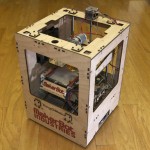
[Update: Welcome back, Slashdot! 🙂 This site is in full lockdown mode, so comments may take a little while to appear, but please leave them anyway! You may also want to check out the previous assembly photos also featured on Slashdot.]
Overview

After a couple months of girlish waiting, my DIY Makerbot Thing-o-Matic kit arrived in December 2010. Pictures of the laborious assembly process went up several days after, and have been viewed by tens of thousands of people in the last few weeks alone. Makerboot does not ship a printed manual with the machinery kit, instead option for an online-only “Thing-o-Matic Assembly Instruction/Users Manual”: a living collection of wiki pages that is continually updated. A good thing, indeed! Take a look at the assembly pictures if you haven’t already gotten a feel for the level of assembly effort. (If you’re good with your hands, allocate about 16 hours.)
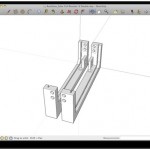
Once the machine is assembled, you’re ready to install the software, connect the machine via USB, and calibrate the system. Rough high-level steps are as follows:
- Install the Arduino driver, if not already installed. (Easy)
- Download and run ReplicatorG, and try making a software connection to the machine. (Easy. You’ll spend a lot of time in ReplicatorG.)
- Use ReplicatorG to manually control all the machines widgets, and test each one for proper function. (Medium.)
- Measure the the Z-axis height and change an obscure config file in your ReplicatorG software that you won’t understand for a few more days. (Medium.)
- Load up some plastic filament. (Easy.)
-

Skeinforge interaction can be a frustrating chore. Within ReplicatorG, launch the embedded Skeinforge configuration application, which is used to take 3D design files in .STL and “slice” them in tooling paths that a machine can follow. This is necessary since 3D printers usually print in layers, starting with the lowest. Skeinforge is an extremely configurable system with an extremely shitty GUI. It is not immediately clear what most of the hundreds of settings do, and you’ll spend many trial iterations configuring options to dial in the best general settings. Even after calibration, you will need to periodically revisit Skeinforge to address build-specific issues. (Hard.)
-
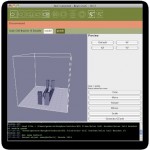
ReplicatorG build platform positional and orientation. Perfect! Use ReplicatorG to either upload a compiled .S3G files to the on-board SD card for disconnected printing, or stream the commands on the fly. (Easy.)
- Run the test job! (Medium.)
- Go to #6. (Daunting.)
The workflow is initially very daunting and cumbersome. It starts to make more sense after a while, but needs major work. This is technically not Makerbot’s issue, but given that it’s a necessary component of the overall system I would suggest major effort be placed in unsuckifying the interaction before ReplicatorG and Skeinforge.
- 3D design software package such as Google SketchUp (free), which is used to design your own objects. Once you’ve designed an object, you export an STL file that is imported into ReplicatorG, which is then sliced by Skeinforge into .gcode files and then by ReplicatorG into .s3g files that the Thing-o-Matics onboard Arduino understands.
- ReplicatorG (and included Skeinforge application), tweaking, compiling, and babysitting.
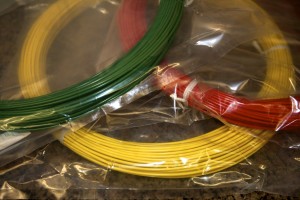
- Extremely cool. You will almost definitely be the only kid on the block with this toy.
- Makerbot maintains the Thingiverse: a user-driven database of open source 3D objects.
- Semi-automated batch jobs via the included Automated Build Platform.
- All needed parts and come with the kit. (BYO tools.)
- Supplies (such as ABS) are also available from Makerbot.
-
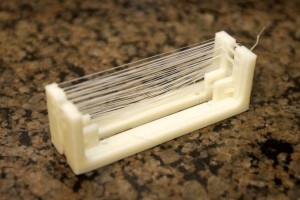
Some parts, such as this pair of brackets printed simultaneously, need trimming and/or sanding. Documentation is 4 of 5. The 5 is for comprehensiveness and getting me through the process, but -1 for ocassionally erronous images, ambiguous text, or omission of step.
-
Minimal soldiering, and much less than I’d anticipated.
- Minimal number of “only one chance” assembly instructions such as cutting and gluing,
- Open Source hardware design. You can print many of your own replacement parts if some break.
- Science!
- Generally not robust enough to run unattended.
- Post assembly calibration gets fuzzy, as there is no 100% Right Way to do things.
- I’m 90% sure that something about the Arduino driver is unstable. I regularly make my entire Mac greyscreen (the OSX equivalent of a Windows BSOD or a Linux kernel panic) during plug/unplug process of connecting/disconnecting the USB from the Makerbot to my computer. Something, somewhere, is dying a horrible death and taking my whole operating system with it.
- Skeinforge–the software that converts your 3D models to tool paths–has an absolutely atrocious (and ofter unstable) user interface. Few of the 100+ configuration options are clearly documents within the app, which is buggy to start with.
- The machine can be somewhat loud and obvoxious. In my case, the XY axes aren’t bad, but the Z axis stepper motor can be very irritating.
- If you do this, you are making a very big time commitment.
- Questionable electronic sub-component failure rates, and one of my biggest complaints. The motor on my MK5 Plastruder was dead on arrival, and my power supply went out after less than a dozen prints. I could just be unluckly, though.

Many small pre-fab printer shops have materialized in the last couple years, ranging from laser-cut wood frames (such as Makerbot), to clear acrylics, metals, and, of course, printed plastics. Regardless of your chosen path, the electronic components are currently not printable in any high-quality manner, are best purchased from a vendor. This includes mainboard microcontroller (the Thing-o-Matic uses as Arduino MEGA), stepper motor controllers, stepper motors, power supply, end stop sensors, extruder controller, cables etc. You can, of course, build these yourself, but in the case of highly available parts such as the Open Source Arduino, it’s far more cost effective to buy the $30 part than spend a day manually fabrication a PCB and hand soldier $20 of mail-order components.
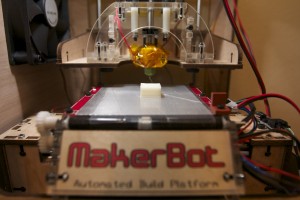
In short, unless you have a Richard Stallman-level of commitment to F/OSS, try to buy all your components from only a few vendors. Makerbot is a good choice for U.S. buyers as though they only sell their own designs–a good thing, IMHO–but then, they don’t sell RepRap parts. If you want a RepRap, the choice is more difficult. I have not built a RepRap, but suspect that even with a larger vendor ecosystem it would be difficult to bring the total price tag for a laser cut or milled non-clone machine to under $1K for quality parts, electronics and components.
- Documentation: 4 of 5
- Ease of Use: 3 of 5
- Coolness: 5 of 5
- Price Competitiveness: 4 of 5
- Support: 5 of 5
- Quality: 3 of 5
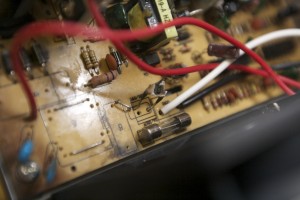
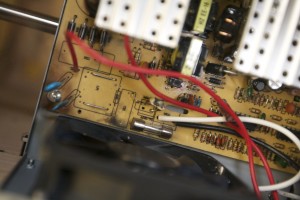
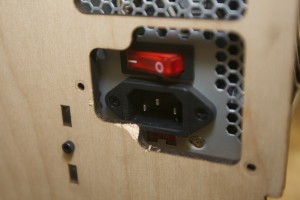
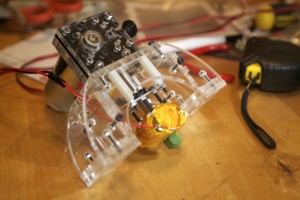
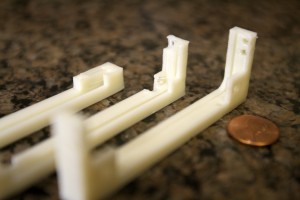
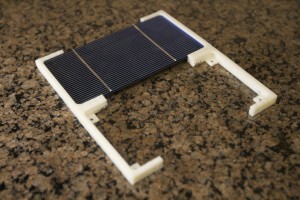

Comments
27 responses to “Makerbot Thing-o-Matic 3D Printer Print Pictures & Product Review”
[…] reading here: Makerbot Thing-o-Matic 3D Printer Print Pictures & Product Review … comments: 0 » tags: custom-robotics, dablings-tend, diy, intricate-parts, makerbot, […]
Thanks for the detailed review. Spot on with the difficulty and manual dexterity required.
Putting together a cupcake myself since they are discounted due to the new model.
[…] This post was mentioned on Twitter by Preston Lee, Ben Vanik. Ben Vanik said: RT @prestonism: [PrestonLee.com] Makerbot Thing-o-Matic 3D Printer Print Pictures & Product Review http://su.pr/8rSsvX […]
Hellooooooo slashdot! (again) 🙂
You mentioned problems “during plug/unplug process of connecting/disconnecting the USB from the Makerbot to [your] computer”.
Check for bad earthing / other voltage problems that may be killing your PC.
With external powered USB devices (incl. HDDs etc) some people have even noticed sparks when connecting using improperly grounded outlets.
The rapman is the closest you can get to a reprap (darwin). I’m surprised the author didn’t mention this great product.
http://www.bitsfrombytes.com/content/rapman
If the objective was to create usable high quality parts, with a machine budget of 1200$ there are desktop milling machines you can even create precision metal parts with out there. With well working software in a fraction of learning time, or even mill molds for plastic parts if you like.
Masochists with too much time and money on their hand may not like the idea of “unsuckifying” the workflow anyway and are happy to produce near random precision plastic junk in the maximum amount of painful effort.
Thanks for the great review.
What do you think about the quality of the parts you can make? My impression from photos/videos of fabbed parts is that they’re quite crude.
It very well could be, or perhaps a DC offset wreaking havoc, though it’s reproducible with different power supply setups. I’m pretty convinced that it’s an issue with the USB/Serial driver since the kernel only seems to blow up on state change events after multiple plug/unplug cycles.
@Mark Green/@Steel
I consider them solid “prototype”-level parts. With a small amount of sanding and razor work they can actually come out looking pretty good, though you often have to make build-specific configuration tweaks. (You can of course paint the parts as well, or even put on a narrower extruder nozzle.) I wouldn’t considered mass producing things for the purposes of retail sale, no, but in terms of making my own little widgets it’s great.
Another nice perk is that, unlike basic home mills, you don’t have to worry about toolhead orientation quite as much (within reason). For example, a simple hole on the XY plane is great for a cheap mill, but unless you have a tool head that can escape the fixed Z orientation, you couldn’t make the same hole in any other plane. (3-axes of movement does *not* imply 3-axes of orientation.) On these low-cost 3D printers, a hole oriented exactly perpendicular to Z is still going to come out better than an off-Z-perpendicular hole, yes, but it’s at least possible to get an off-axis hole approximately correct and then do a little sanding/knife work to clean up the flaws a bit.
There are also entire classes of objects–such as hallowed areas, or sections with internal complexities implausible for a the tool head to reach–that simple aren’t possible with a similarly-priced mill.
So yeah, there are major cons to working with plastics, but there are also significant pros. The specific design need will dictate which works better for a specific application, and none will be perfect for every possible need.
Also note that the wooden and acrylic pieces of the Thing-o-Matic are actually laser cut, *not* printed, and still require filing/sanding during assembly.
With regards to USB-to-serial drivers on OS X —
These drivers seem inherently flakey on OS X. I’ve seen this problem most severely with the FTDI driver used on older Arduinos (and many, many other places), but I’m not surprised to hear that it happens with AppleUSBCDC.kext driver used by the newer Arduinos. (It also happens with my FitBit base station, which uses a SiLabs driver…)
If you want to confirm this, run “sudo nvram boot-args=”debug=0x144” and reboot your computer; you’ll start getting real panic messages instead of the gray screen.
Ultimately, the only solution I’ve found (in years of banging my head against this problem) is to never unplug one of these devices while you have a program running that is holding the connection open.
@bushing,
That description is 100% in line with my observations. Having an open connection (by running ReplicatorG etc.) + plug/unplug several times => explodey time.
concur with @bushing, I get the same thing using Arduinos – everything points to the FTDI driver.
Solution – don’t unplug while serial comms is running.
You note that only minimal soldiering is required. I suppose the soldiering is necessary when the makerbot starts self replicating and tries to take over the world, and am glad this is kept to a minimum.
Hi Preston: Thank you very much for your review, I think from what I see this is not the solution for my intentions.
Anyway, just to be completely sure, I’d like to have one part printed ( 10x100x3 mm approx ) printed to see and feel what the best printing quality of it with a thing-o-matic can be.
Question now is: Would you be able to print it for me and send it over to Montreal, Canada if I provide the .stl file ?
If so, let me know where to upload the file.
I will cover all costs involved.
Thank you
Pablo
Thank you for this post. I’m a software developer with NO robotics / electronics experience, and am thinking about getting one of these things – I realize this might be well over my head, but would like your opinion.
I don’t mind spending hours following instructions and tinkering – to the extent as a guy who doesn’t know what he’s doing can “tinker”, anyway – and would look forward to the challenge, assuming I have some decent chance of succeeding.
How likely would I be to just wreck the thing, or to never get it working properly? Are the instructions sufficient for a newbie with patience to actually follow, or will it likely require a lot of reading between the lines, and experienced improvisation?
Any advice greatly appreciated! I’m hoping it’s not *actually* rocket science 🙂
N00b out,
Mike
Ooohhhhhh that’s a toughy. 🙂
*If* you are good enough with your hands to solder, assemble small parts and troubleshoot basic mechanical processes you have a pretty good chance of succeeding. Much of the guide is fairly ho-hum busy work, though a part may give you grief, here and there. If you’re good with computers and understand the hows and whys of basic components–in other words you’ve built your own machines before–I wouldn’t worry about the electronics components too much.
You do need patience, though. Lots and lots of patience. HTH!
Preston
On the power supply – there’s currently a big problem with “fake capacitors” from China making their way into mainstream components. You can google it easily – but many have figured out their project instabilities due to these. Some pics show old salvaged capacitors “re-cased” and re-sold as new. The old/salvaged had only vaguely close specs for capacitance, voltage rating, etc.
Even google all the problems with the Cisco access points (home ones) the problems are sucky caps.
So I’m guessing that’s it – not power draw. Anyway, the caps wouldn’t really affect power capacity – just smoothness of the power.
@Mike,
I wouldn’t doubt it at all. A capacitor shouldn’t fail after so little use like this.
@ NoPainWithSteel
I think the idea here is to prototype something without making a steel mold first. Mold’s are not always so easy to tweak and just being able to find out what works before even contemplating designing a mold is a very exceiting thing. I work with Solidworks to Camworks to $60,000 CNC machine and it’s still not just a breeze to make complex molds with moving cores, ejectors, cooling systems not to mention worrying about plastic flow. But, I’m an Automation Engineer at a contract medical injection molding plant and I can’t wait to get one of these!
[…] Found a good review of the Thing-O-Matic here. It’s a pretty clear run-down of the pros and cons of owning an early generation 3D printer, […]
I can’t be sure from your pictures, but I suspect that the exploded component in your power supply is an MOV (Metal Oxide Varistor), not a capacitor (though they do look similar). It’s a surge suppressor for the AC power line and it’s quite common for them to explode if there’s a surge. Since they’re placed in parallel with the line, when they explode the device usually still works (until the next surge comes along and blows a different component). It’s likely that there is a second problem with your power supply.
Charlie: Thanks for the note. If that’s the case, could the high current load on the unit cause this, or would it most likely be an input voltage spike?
Hi Preston, I read your blog about the thing-o-matic and was very impressed with your knowleddge and reporting. I’m interested in modeling small (6 inch) plastic doll replica’s of friends out of plastic from from photographs. Do you have any suggestions for what companies are experts at this, or what might be the best available options?
Thank you, Brian Gilbart
Hi Brian,
Out of 2D photos I’m not sure, but there are some great videos on building cheap DIY 3D scanners which can pop out model files that can be converted to print jobs. I’m interested in eventually doing this myself, so please report any progress!
Preston
I think the company should sell extrusion material at cost–just to
promote the machine?
I think the printers will one day become common
place.
I’ve had so many little plastic parts break(tent pole couplings, dish washer
parts(wheels), lures, smog parts on cars, etc.